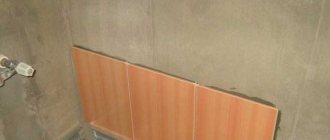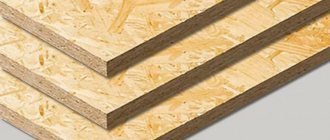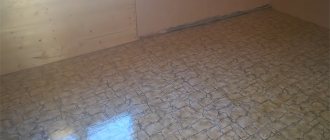The standard layout of a living space rarely allows the owners’ design ideas to be realized. Then homeowners think about refurbishment of the “squares”. But most design changes fall under redevelopment, which means they need permission from the housing inspectorate and other supervisory authorities.
However, you don't always need to worry about this. If you know which redevelopment of an apartment or house does not require approval, you can significantly reduce time and financial costs.
What kind of redevelopment does not require permission?
Structural changes to residential areas that require inclusion in technical and cadastral documentation are considered redevelopment. If, as a result of such changes, it is expected that the area of residential and non-residential areas will change, and the walls will change their original position, such activity should only take place with the permission of the housing inspectorate.
But if we take into account the definition of redevelopment in the Housing Code, then it is necessary to coordinate only changes that can affect the structural integrity of an apartment or house, changes in its area and blocking of ventilation outlets and communication lines. Those works that do not affect the above indicators are considered permitted and do not require any additional legalization.
What types of redevelopment do not need to be approved:
- design or sewing of openings in non-permanent partition elements;
- disassembly of mezzanines, closets;
- installation of door panels, including rotating and sliding ones, and display cases without changing their dimensions;
- arrangement of built-in furniture and household appliances without creating new closed areas;
- installation of a partition that can be easily disassembled and moved to a new location.
You do not always need permission to glaze a balcony or loggia, even though it is a redevelopment. If the load on the floor slab hardly increases, and the appearance does not deviate from the design concept of the building, then upgrading these elements can be done without any approval. Unless, of course, your house is one of the cultural and architectural monuments. In this case, you need to obtain the consent of specialists from the relevant department of the locality administration.
You can also install an additional hood and split system without removing the old ones, and install a mosquito net.
Actions that do not require approval and are not considered redevelopment also include cosmetic repairs of any complexity. This can be wall, ceiling and floor coverings. This category also includes the replacement of plumbing fixtures, as well as elements of the heating system. But, say, moving plumbing into a room, even without changing the pipeline outlets, is impossible without approval.
It is quite possible to legalize illegal redevelopment if it does not violate construction and sanitary standards. But, quite possibly, there is no need to do this if the changes are not those that require permission.
Redevelopment of rooms with moving walls
The main rule applies here: when redeveloping your apartment, the living conditions of the neighbors above and below, including yours, should not worsen. Walls should be moved taking into account these rules:
In repairs involving walls, you also need to look at whether they are load-bearing or non-load-bearing. If you have partitions, then you can demolish them and build new ones. With load-bearing structures everything is more complicated - the house is supported on them, so you cannot:
- demolish load-bearing walls entirely;
- cut openings in load-bearing walls without the consent of the author of the house design;
- make new openings without reinforcement.
If you decide to make an opening in a load-bearing wall, you need to look at the BTI plans of your neighbors above and below to see if they had the same redevelopment. Read more about this here.
When affecting load-bearing walls, you should always contact the authors of the house project - for example, MNIITEP or the State Budgetary Institution "Expert Center". They will give an opinion on the possibility of redevelopment.
This is what correctly executed openings with reinforcement with metal structures look like:
In addition, in the apartment you cannot:
- sheathe heating risers without easy access. It is necessary to use only easily removable structures, which will not be difficult to remove with a specialist from the Moscow Housing Inspectorate;
- make heated floors from radiators.
Is permission required for the conversion of non-load-bearing walls?
If you start modifying non-permanent walls without moving them, in most cases the redevelopment may not be approved. This may involve dismantling old structures and erecting new ones in the same place in strict accordance with the technical passport.
There is no need to regulate partition structures built in a new location if they are small in size and can be easily dismantled.
These include:
- light arched partitions;
- bar counters;
- kitchen islands;
- ledges and niches;
- rack bulkheads;
- glass sliding doors;
- openwork screens and various screens.
If you intend to install a partition that does not carry a load on the floor slab, complies with sanitary standards, but at the same time transforms the living space, you will not need to obtain permission for redevelopment from the housing inspectorate.
It will be enough to make a change to the technical plan in the BTI according to the sketch and to the Rosreestr data. The most common example of such redevelopment is the division of adjacent rooms into separate ones. All these actions are provided for by the Housing Code. According to it, any changes that are made to the design of the housing or related to its area must certainly be reflected in the technical passport. Even if you don’t need to obtain planning permission.
The procedure is quite simple: a specialist from the Technical Inventory Bureau inspects the premises, compares it with the sketch and gives the go-ahead for repair work. After this, a check is carried out and a new technical document is drawn up. If such a redevelopment has already been done, it is easiest and fastest to legalize it.
It is important that not only the areas of residential and non-residential premises do not change, but also that the load on the flooring does not increase. If it is decided to erect a heavy monolithic wall, it will require approval, since violation of the technology can lead to the destruction of the building.
When modifying partitions, it is not permitted:
- construction and removal of load-bearing walls;
- construction of false walls that create blind areas without lighting and central heating;
- structures that change the architecture of the building.
It is also not allowed to embed a gas pipeline into a new wall or block ventilation outlets.
It will be necessary to submit an application for redevelopment to the housing inspectorate and create a project if it is planned to move partition structures under windows and doors, increase living space at the expense of non-residential premises, or arrange additional non-residential areas, for example, storage rooms.
Preparatory work before demolition of walls
Preliminary work is carried out before demolition. All things and furniture are removed. The general heating system, water supply, electricity, gas, TV antenna and radio point should be turned off.
You also need to prepare bags for garbage disposal. If the volume of waste is large, then you should take care of the dumping site in advance. It is necessary to know the regulations for carrying out repair work in high-rise buildings. On weekdays this is from 9 am to 7 pm. On weekends, silence should be maintained, and you should not use devices or units that create vibration.
If the volume of waste is large, then you should take care of the dumping site in advance.
Is a permit required to demolish or move a non-load-bearing wall?
If the new wall does not affect the main floors, does not load them, and does not change the area of the apartment, its construction is not classified as redevelopment, but as repair or reconstruction work. No permitting documentation is required. And to legalize it, you don’t need to contact the housing inspectorate. It is enough to communicate with BTI specialists.
No approvals are required at all if your partition can be easily disassembled. Even when selling an apartment, if the structure is not needed by the new owner, it will simply be dismantled.
But before starting renovations, you need to independently find out all the nuances of the housing complex, sanitary and construction standards, or seek advice from the design bureau. It is possible that in your case you will need to make changes to the technical passport and coordinate them with the supervisory authorities.
Some types of wall transfers cannot be performed, even if they are not major. Not allowed:
- reduce the area of rooms by more than a quarter;
- move partitions so that rooms without windows and radiators are formed;
- cover the utility network with a permanent bulkhead or truncate the ventilation duct.
There is also a ban on reducing the size of the kitchen. This room is the most fire hazardous in the apartment. As the area decreases, the risk of fire increases.
As for the demolition of non-permanent partition structures, there are some nuances here. There are certain prohibitions on dismantling even non-load-bearing walls. These include the removal of partitions installed in different rooms:
- demolition of the wall between the room and the kitchen with a gas stove in a one-room apartment;
- combining the landing and corridor;
- elimination of thresholds located on balcony exits;
- expansion of the loggia at the expense of the room;
- dismantling window sill blocks;
- connection of two residential properties if their owners are different people.
The partition between the bathroom and the kitchen cannot be demolished. But it is not difficult to agree on the combination of a toilet and a bathroom into a single zone - such a transformation will only need to be certified by the BTI.
If a partition structure has already been erected in an apartment purchased on the secondary market and is not included in the technical passport, it must be made legal. Or dismantle without any approval - demolition of a structure not specified in the documentation is not included in the redevelopment of the apartment.
How to demolish a wall in an apartment yourself
If you want to change the layout of your apartment or house, you can dismantle the walls. However, there are certain rules that apply when doing this job. One of the main ones is the inadmissibility of removing load-bearing structures. In addition, there should be no electrical wiring in the demolished walls. If present, it must first be de-energized.
Sometimes there are water pipes in the walls of apartments and houses. You need to be very careful with them, because you can deprive the entire house of water or heating. Even if you plan to only move the doorway, you must obtain the appropriate permission.
What are the rules for dismantling partitions How to dismantle a brick partition Instructions for dismantling brick walls How to dismantle concrete partitions Dismantle wooden partitions Demolition of plumbing walls Work algorithm The wall between the room and the loggia
What are the rules for dismantling partitions?
Before you start demolishing a wall in an apartment, consult with the authorities, for example, with the management company, about this work. Whether a wall is load-bearing or not can be checked by looking at its position. Typically, such a structure is oriented perpendicular to the beam.
External walls are load-bearing, and internal walls usually act as partitions. If there is any doubt about the load-bearing capacity of the wall, the structure should be checked. Thickness indicates fate. The structure in a panel house is load-bearing with a thickness of approximately 210 cm. If we talk about partitions, this parameter varies from 80 to 100 cm. If the building is brick, then the load-bearing walls in it have a thickness of more than 300 cm, and the average thickness of the partitions is 100 cm.
Before demolishing a wall in the apartment itself, you need to decide on the façade of the work and the algorithm of actions. Start this process at the top, where the partition meets the ceiling. In this area it is necessary to work with a chisel and a hammer. The work will go faster if you have a hammer. The easiest way to break a plasterboard wall in an apartment yourself. In this case, you can do without a hammer.
In the part of the wall where the doorway is located, there should be a concrete lintel at the top. It is best to remove them with the help of a second person. In the case of a wooden lintel, it is usually covered with plaster. This layer has been previously removed. The remaining frame should be dismantled by removing individual boards. To break down a drywall partition, first remove the decorative covering. To do this, holes are made in the canvas with a pick for culverts. The material can then be easily torn off by hand. If you have a screwdriver, unscrew the mechanical fasteners and remove the tarp completely.
How to dismantle brick partitions
The demolition of brick walls and partitions is carried out in several stages. First you need to prepare for the work, draw up a plan for its implementation, and only then can you begin the process. The dismantling schedule may vary depending on whether the wall is being removed completely or partially. If the material at the base of the partition has not lost its performance qualities, it can be reused. Only in this case is a gentle method of removing walls used.
Attention! Removing the wall should not damage the floor covering. This point should be taken into account, since the material at the base is quite heavy.
By the way, you can try to avoid excessive dust formation in the apartment. To do this, wet the partition with water before it is broken.
Instructions for demolishing brick walls
Demolition of walls in an apartment begins with preparing the tools that may be needed:
- choose; chisel; with a hammer; with a hammer; sledgehammer.
Electrical wiring, if any, is removed. If it is no longer in use, it simply turns off to prevent interruptions and short circuits. All baseboards and trim are removed. The plaster must be removed. A sledgehammer and a chisel will help you deliver the first blows, which should be the strongest. This will reduce the connection between the parts and the wall will break.
It will be easier to dismantle if clay was used for masonry. Even if dismantling the walls also involves further replacement of the floor, you should disassemble the partition in parts, preventing large pieces from falling onto the floor. This may damage the floor.
How to dismantle concrete partitions
Before you demolish a wall in your apartment, you should think about what tools to use. To remove a concrete partition, it is best to use the following tools:
- jackhammer; strike with a fist; Angle grinder.
This equipment will allow you to deal with the metal frame inside the structure. In this case, it is also impossible to completely demolish the wall. You can use a hammer drill set to chiseling mode. But this approach is sloppy, and the work will be accompanied by a lot of noise.
In order to demolish a wall in an apartment, you can drill holes with a hammer drill or drill. The area of the partition is preliminarily marked into sections. You can demolish a partition in an apartment by connecting the openings around the perimeter. Use a hammer and chisel to press out individual pieces.
Dismantling wooden partitions
The work of demolishing a wall in an apartment will look somewhat different if the partition is wooden. Remove the top layer of plaster and disconnect or remove the wiring. To break walls, you can use a punch and a wide chisel. The work in this case goes quite quickly. At the next stage, dismantling the wall will involve sawing off individual fragments of the structure.
Attention! The easiest way to dismantle the work is to use a reciprocating saw. Using a hand tool in the form of a nail or an ax will cause the process to take a long time.
Demolition of bathroom walls
Probably the most difficult step in your renovation will be removing the wall between the bathtub and toilet. Looking at photos of modern bathrooms, you can understand that when combined they look much more attractive. The first step is to obtain approval for the redevelopment. If the area of the premises is planned to be increased at the expense of other premises, permission must be obtained.
The project will be needed if you want to increase the number of plumbing fixtures or move them to another location. Another prohibited method is moving ventilation ducts and changing their shape. After looking at many photos, you can understand what scheme to use to dismantle the partition in the apartment. To complete the work you may need:
- perforator; mill; chisel; hammer; individual protection means; nail puller; bit.
Coordination of moving the doorway
When redeveloping residential premises, the question often arises about the need to coordinate the relocation of the doorway. After all, there is no transformation of the areas.
There is the same nuance here as when constructing a new bulkhead. If the structure where the location of the door is changed or an arch is made is easily dismantled, then there will be no problems with the openings either. Such actions do not require any permission or subsequent legalization, since they are not considered housing redevelopment.
But in other cases, moving a doorway in a non-permanent wall will require contacting the BTI. After all, despite the fact that there were no changes in area, the doors are marked in the technical plan. Therefore, the documentation will have to be updated. But it’s easier to do this; there’s no need to even change entries in Rosreestr.
Entering new data into the technical plan will be sufficient here, in contrast to transforming openings in the main walls. There, permission from the housing inspectorate is required, because such refurbishment can affect the structural characteristics of a residential building.
There are also prohibited aspects in the formation or sewing of openings. So, you can’t cut a second passage to the kitchen. In this case, a wind tunnel is created, which impairs ventilation. It is also prohibited to modify window openings in main walls.
Which walls can and cannot be dismantled?
Most often, reconstruction occurs in connection with an expansion of the area or a change in its functional value. A large percentage of alterations occur on the ground floors, in which it is planned to open a store or beauty salon in the future, and so on. Here the wall may be part of the foundation, therefore a full inspection of the structure by specialists is required, followed by permission.
A large percentage of alterations occur on the ground floors, in which it is planned to open a store or beauty salon in the future, and so on.
Window and other openings. It is important to determine the nature of the surface, based on which the further appearance of the building’s façade will be designed. Reducing light openings in high-rise buildings is quite problematic. You can increase them.
Dismantling a wall in a panel house is a more affordable option, but only for external surfaces. The reason is that during the construction of a building, the entire load is “taken” by solid or prefabricated modules made of iron and concrete. However, the main wall can still be dismantled. In its place, supports are installed to strengthen the structure. The supports are subsequently decorated to match the interior of the room.
Dismantling a wall in a panel house is a more affordable option, but only for external surfaces.
What changes will have to be abandoned?
According to sanitary and building standards, transformation of residential premises is not permitted, which is capable of:
- worsen the general operating conditions of the building and the requirements for people living in it;
- impede access to main utilities, including water supply, sewerage and energy supply networks;
- violate the strength and change the stability indicators of main walls and ceilings (to avoid destruction of the building);
- reduce the diameter of the ventilation ducts or simply remove them.
If your idea falls under any of these points, it will never be allowed. If illegal redevelopment is detected, representatives of supervisory authorities demand a complete reversal of transformations not permitted by law and will issue a fine for illegal redevelopment. Such strict rules are due to the fact that changes in the house can pose a danger or cause discomfort to those living in it.
The same applies to increasing the load on load-bearing elements in excess of what is permissible according to the design documentation:
- when installing new screeds on the floor;
- when dismantling light partitions and replacing them with floors made of heavy materials;
- when placing additional equipment in the living space.
However, some overloads of capital floors are sometimes allowed.
This is possible in the case of additional structural reinforcements according to a carefully verified project, which will require significant costs and largely depends on the material from which the building is built, its service life and number of floors. So, for example, with approval, you can create a new doorway in a solid interior wall of a good-quality house. Banned changes that are never approved:
| Premises | Redevelopment that will be denied |
| The whole apartment | Construction of openings in areas connecting connecting structures with prefabricated elements. |
| Creation of grooves for electrical communications or water mains in horizontal joints under wall panels, in floor slabs. | |
| Installation of heated floors by removing coolant from a common heating pipe. | |
| Dismantling of load-bearing walls and ceilings. | |
| Dismantling of window sill blocks. | |
| Construction of partitions that block natural light and divide rooms into zones without heating. | |
| Rooms | Reducing the area by more than a quarter. |
| Kitchen | Combination with a room in a one-room gasified apartment. |
| Bathroom | Relocation of inputs and outputs of hot water supply lines, hot water supply lines, drainage pipes - the so-called “wet places”. This also applies to the kitchen. |
| Transferring plumbing fixtures to a living room or hallway. | |
| Balcony and loggia | Increasing the area of the architectural element due to the living room. |
| Expansion of existing structures at the entrance to the living space. | |
| Demolition of thresholds located on balcony exits. | |
| Installation of radiators and cooking appliances. | |
| Corridor | Connection with staircase. |
If your idea is not on the list, the likelihood that the redevelopment will be approved is high. If no fundamental changes are expected, then the decision of the BTI with the inclusion of new indicators in the technical plan and in Rosreestr will be sufficient. If the redevelopment is significant, then a project will be required. It can also be ordered from the BTI or contact a specialized bureau.
In case of illegal redevelopment, the type of which is prohibited, it is worth trying to return the home to its previous appearance. It will still not be possible to legalize it, but an administrative penalty in monetary terms will certainly be imposed.
Necessary tools for dismantling walls
The choice of tools depends on the type of wall to be demolished. To dismantle brick walls you will need a pick, a crowbar, a jackhammer, in some cases a sledgehammer, and metal wedges.
Concrete walls are destroyed using a hammer drill, grinder and jackhammer. For demolition of wooden floors - a chainsaw.
The choice of tools depends on the type of wall to be demolished.
How to arrange a reorganization
If your redevelopment is one that does not require approval, you do not need to formalize anything. You can safely purchase building materials and do repairs. In other cases, you will need to collect documents, without which the application for the possibility of redevelopment will not be accepted. It is compiled according to the state model, which can be found on the resources of the MFC, BTI and housing inspection.
It must be accompanied by:
- a document from Rosreestr confirming that you are the owner of the property;
- technical certificate of the premises;
- written approval of all registered on potentially redeveloped square meters.
If drastic changes are proposed, design documents will be required.
BTI or design and architectural bureaus will help with this. You only need to contact licensed organizations. Difficulties may arise if the building has cultural or historical heritage status. In this case, you will need permission for redevelopment from local administration specialists supervising these areas. Practice shows that they are not very willing to agree on changes.
The owner of a non-residential premises who wants to redevelop it cannot be just an individual. Changes in such buildings are allowed only to the founders of an LLC or individual entrepreneur.
When all the papers have been collected, you need to contact the MFC, housing inspectorate or administrative department that oversees housing issues in your city. After submitting the application, you will need to wait a month and a half for a decision, although usually everything is agreed upon faster - in two to three weeks.
After this, you will receive a permit document, which will indicate the time given for the redevelopment. After its expiration, the selection committee will come to visit you and evaluate the quality of the changes and their compliance with the project. If everything is done correctly, changes will be made to the technical and cadastral plan, as well as to the Rosreestr records for your redevelopment.
It is necessary to distinguish between redevelopment and reconstruction. The latter refers to changes in the field of engineering and technical communications. For them, permits must be obtained from Rospotrebnadzor, fire services, environmentalists, and the Ministry of Emergency Situations. But communication with BTI representatives is most often not required, since nothing usually changes in planning documents during reconstruction.
Not all redevelopments are approved immediately, even those that do not violate the requirements. There is a risk of being rejected. If there is a slight misunderstanding or problem, you can make corrections to the project and come back with a new application after 90 days. In this case, a review of the previous decision should be required. Another groundless refusal can be challenged in court.
If you need to legalize redevelopment that has already been done, you need to contact the Technical Inventory Bureau. Perhaps a sketch will be enough to correct the technical plan. Simple and compliant changes are legalized quickly and without problems. After this, you will receive new cadastral and technical documents, and information about your real estate will be changed in Rosreestr.
If the housing has been significantly changed, in order to legalize the redevelopment, you will have to go to court. To do this, you will need the same list of documentation as when filling out the application, as well as an assessment by specialists who will conduct a construction and technical examination. If fire, sanitary and hygienic and building standards are not violated, the likelihood of a decision in your favor is high.
What to do if they refuse?
In what cases can approval be refused? Most often, this problem occurs in two main situations:
- Not all necessary documents were provided, the application was filled out incorrectly, and so on (the problem can be resolved quite quickly, without going to court).
- The requested redevelopment violates legal requirements. In such a situation, if you try very hard and use the help of an experienced lawyer, you can even try to agree on something that seems to be strictly prohibited through the court. In practice, if the changes being made are really very significant, then the court will not help in any way.
What are the dangers of unauthorized reconstruction?
If redevelopment of an apartment does not require permission, the owner of the squares will not face anything. He can safely sell, exchange, donate real estate, and invite representatives of supervisory authorities to visit. A small illegitimate redevelopment.
The consequences of large-scale illegal redevelopment of an apartment without approval are disastrous. Of course, until the fact of transformation of the area is revealed, the owner of the premises lives quietly, sometimes for decades. But if he wants to sell or donate the apartment, or neighbors complain about the consequences of the redevelopment, he will have to try to legitimize it.
Some citizens transform their homes as they please, so legalization is not always successful. Such a person will have to pay a fine of 2,500 rubles and restore the property in accordance with the technical plan.
If the owner of the “squares” refuses, and the court does not side with him, his apartment can be sold at auction, and part of the proceeds from the sale will be used to return the design characteristics. In this case, the wishes of the former owner will not be taken into account.
Even if it seems to you that the planned refurbishment of housing should not require either approval or permission, it is still better to get advice from the BTI. There may be a need to make changes to the technical and cadastral passport, or even the creation of a project will be required. It is better to approve all changes in advance than to pay fines and go to court later.
How to understand whether you can do redevelopment or not
If you cannot figure out what work is allowed and what is not, contact a redevelopment approval company - it’s faster and more reliable than searching for information in different sources.
At APM-1, consultation is free. You can write to us by email or call +7(495) 181-13-09.
If necessary, an engineer will schedule a visit to your apartment to inspect it and check for any problems. Extensive experience in working with the Moscow Housing Inspectorate allows us to make accurate forecasts and take into account what inspectors do or don’t let in in practice.
If we understand that some work cannot be completed, we will definitely tell you about it and offer options for solving the problem.
Leave a request for a free consultation on apartment redevelopment
Zamyatin Dmitry Alekseevich
Zamyatin Dmitry Alekseevich
General Director of LLC "APM-1" Design workshop PEREPLAN.
Education: Higher technical (Master's degree from Moscow State University of Civil Engineering)
Specialization Coordination of redevelopment of commercial and residential real estate in Moscow and St. Petersburg
Why remodel
The motives are to increase comfort, create amenities for a specific family, rational use of space, designate places of work, recreation, children's leisure, etc. Most often the layout is changed as follows:
- combining two bathrooms into one;
- connection of the kitchen and living room, with zoning of the dining room;
- creation of niches, mezzanines, dressing rooms, storage rooms;
- insulation of the loggia, connecting the balcony with the living room;
- changing the location of doors, entrances (in load-bearing walls);
- connecting rooms, etc.
The use of dividers – curtains, furniture and other easily portable structures – will help solve the problem of zoning in a small apartment. This does not entail mandatory registration and is not included in the technical passport.
Before you remodel your home, you need to find out what can and cannot be changed in the apartment, and also read how to independently legalize redevelopment in the apartment.
General rules of the process
Dismantling partitions can lead to structural problems. When knocking out a large section of the wall, there is a risk of the ceiling collapsing, which will lead to irreparable consequences.
It is recommended to follow some rules when carrying out redevelopment or demolition of interior partitions:
- The partition is dismantled in small sections, subject to safety standards.
- If there is a doorway, dismantling the structure begins from this area.
- A sledgehammer is often used as the most suitable, simple tool.
- Disassembly must be done from the ceiling down.
A number of techniques that can help to carry out proper dismantling:
- During the dismantling process, you should visually determine the size of the pieces being removed and, if necessary, break them into smaller ones.
- Dismantling concrete partitions will create some difficulties. Therefore, it is better to use a special power tool. It could be Bulgarian. This generates a lot of dust, and therefore all manipulations are carried out with open doors and windows.
- Dismantling with a sledgehammer is considered a quick but energy-consuming method.
- Disassembly can be done with a hammer drill or drill. More through holes need to be drilled. Then all that remains is to use a sledgehammer to knock out the elements along the marked perimeter.
To reduce dust formation, it is recommended to spray partitions made of concrete and brick with water. Also, to collect dust and create an obstacle when leaving the room, a wet sheet is hung.











